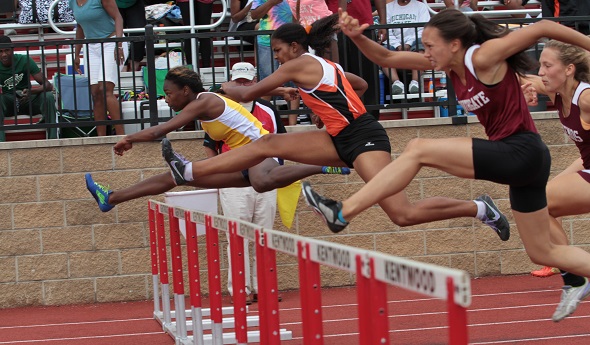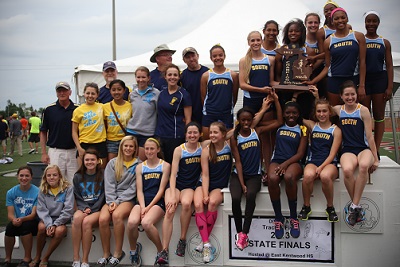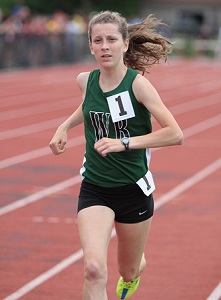
Seniors Cap Record-Setting Careers
By
Tom Kendra
Special for MHSAA.com
June 1, 2013
KENTWOOD – There was no mistaking the marquee event at Saturday’s Lower Peninsula Division 1 Girls Track and Field Final.
With three of the top girls distance runners in the entire country competing, the 1,600-meter final had the undivided attention of a huge throng at windy, but sunny, East Kentwood High School.
Hannah Meier of Grosse Pointe South ran a Finals record time of 4:39.23, outdueling her identical twin sister, Haley Meier (4:42.43), and Erin Finn of West Bloomfield (4:45.37), in a race that was a three-way dead heat with one lap to go.
“I saw them coming up on me with 400 meters to go, and I knew I had to pick it up even a little more,” said Hannah Meier, who will run next year at Duke University, along with her sister. “They pushed me and I finally broke 4:40. I’ve been wanting to break that for a long time now.”
The winning time was announced as the sixth-fastest 1,600 meters ever run by a high school girl in the United States.
The epic victory in the 1,600 was one of her four firsts on Saturday for Meier, which powered Grosse Pointe South and Coach Steve Zaranek to their third-consecutive team championship. Meier also won the 800 meters and ran legs on South’s winning 3,200-meter and 1,600-meter relay teams.
The Blue Devils won with 76 points, followed by Saline with 55, host East Kentwood (47), Rochester Adams (42) and Macomb Dakota (32).
 Saline posted its best-ever Finals finish behind junior Quenee Dale, who won the 100-meter hurdles and also ran a leg on the Hornets’ winning 400-meter relay team.
Saline posted its best-ever Finals finish behind junior Quenee Dale, who won the 100-meter hurdles and also ran a leg on the Hornets’ winning 400-meter relay team.
The final showdown between the Meier twins and Finn, who have dominated Michigan girls track and cross country since bursting onto the scene in the fall of 2009, was certainly the main storyline of Saturday’s Division 1 meet. But while fans were saying goodbye to those three distance legends, they got to know a new sprinting sensation.
Sekayi Bracey, a 15-year-old freshman, almost single-handedly delivered East Kentwood its third-place finish by winning the 100 meters (12.18), 200 meters (24.82) and placing third in the long jump (18 feet, 5.25 inches).
“I was very confident coming in, and I just tried to visualize each race in my head,” said Bracey just moments after winning her final race of the day, the 200 meters, on her home track. “I feel tired right now, but it was worth it.”
Bracey certainly didn’t run away from the field, having to hold off major challenges from second place Dominique Funchess of Detroit Renaissance in the 100 and Anna Jefferson of Oak Park in the 200.
The third-place Falcons also received an individual first place from senior Mariah Davis in the shot put.
 Finn continued her dominance of the longer-distance races by putting on a show in her final high school race, the 3,200 meters. Finn, who will run next year at Michigan, won the race by a whopping 34 seconds – setting an all-division Finals record with a time of 10:08.23.
Finn continued her dominance of the longer-distance races by putting on a show in her final high school race, the 3,200 meters. Finn, who will run next year at Michigan, won the race by a whopping 34 seconds – setting an all-division Finals record with a time of 10:08.23.
Finn acknowledged afterward that she was hoping to go sub-10 minutes.
“I went out there with the goal of the 10-minute barrier,” said Finn. “But that’s OK. I set really high goals and try to get close to them.”
Cierra Pryor of Jackson broke her own meet record from a year ago, winning the long jump with a leap of 19-0.5, a half-inch better than the year before.
The Meiers closed out the meet and their storied prep careers in fitting style, powering the Blue Devils to victory in the 1,600-meter relay.
“The most important thing for us today was to win another team state championship for South,” said Haley Meier. “I didn’t feel that great today, but I had to give it all I had for my team. This is a great way to go out.”
Earlier in the day, the Meiers opened the running portion of Saturday’s finals by each running a leg on the winning 3,200-meter relay team in 9:01.98. The other members on that winning team were Ersula Farrow and Christina Firl.
That impressive time was still 13 seconds slower than South’s 2012 winning time of 8:48.29, which is a National Federation of State High School Associations record. That team featured the Meier twins, Farrow and Kelsie Schwartz.
Winning the two sprint relays were Saline (400-meter relay) and Detroit Renaissance (800-meter relay).
Other individual champions were Jae’vyn Wortham of Harrison Township L’Anse Creuse (discus), Kerri McMahon of Novi (high jump), Jane McCurry of Plymouth (pole vault), Anna Jefferson of Oak Park (400 meters) and Breanna Luba of Southgate Anderson (300-meter hurdles).
PHOTOS: (Top) Hurdlers leap in stride Saturday at East Kentwood. (Middle) The Grosse Pointe South team poses on the medal stand after clinching the LP Division 1 championship. (Below) West Bloomfield's Erin Finn finished her high school career with an all-Finals record in the 3,200. (Photos by John Brabbs. Click to see more photo coverage from RunMichigan.com.)

Hastings Relays Reigns as State's Oldest Continuous Track & Field Meet
By
Steve Vedder
Special for MHSAA.com
April 10, 2024
Bob Branch remembers dabbling in other sports, but his first love was always running.
 The Hastings High School graduate admits he could never hit a baseball, football didn't especially appeal to him and basketball was just another way to spend time with friends. But for Branch, now 93, there was always track. That's the sport where his fondest and sharpest memories remain. And if you're talking track, many of his favorite memories come from participation in the state's oldest continuous track meet, the Hastings Relays.
The Hastings High School graduate admits he could never hit a baseball, football didn't especially appeal to him and basketball was just another way to spend time with friends. But for Branch, now 93, there was always track. That's the sport where his fondest and sharpest memories remain. And if you're talking track, many of his favorite memories come from participation in the state's oldest continuous track meet, the Hastings Relays.
Always held in early April, the meet dates back to 1937 – a bygone time that saw the first hostilities of World War II, gas at 20 cents a gallon and a loaf of bread selling for a dime.
And at a dusty old track surrounding the county fairgrounds in Hastings, a small relay event that included a scattering of participants from a dozen high schools was taking its first tentative steps.
Branch recalls a time when kids would run home after track practice because there were no buses, inexperienced young coaches had little actual knowledge of running fundamentals, and athletes looked at the sport as an afterthought after spending most of their high school days playing football and basketball.
 For Branch, the relays were the ideal way to ease into the track season.
For Branch, the relays were the ideal way to ease into the track season.
"I just liked to run," said Branch. "I remember I anchored a relay with my brother, and it always seemed cold when we had that meet. I remember teams would come from all over and you saw a lot of good athletes. Everybody seemed to have someone who was really good. Track wasn't very popular at that time, but I have a lot of good memories from running."
The Hastings Relays, which has changed formats and even names during its nearly nine-decade history, would traditionally kick off the track season. The meet was originally held at a makeshift quarter-mile track which surrounded the town's fairgrounds and was part of the city's annual Hastings Carnival – the track would become the midway during fair time.
The meet eventually moved to Johnson Field when the football field was dedicated in 1949 and ballooned to as many as 50 teams at its peak in 1957. For more than seven decades it was known as the Hastings Relays and then the Hastings Co-Ed relays before becoming the current Hastings Invitational, with the latest edition scheduled for Friday.
Johnson Field had a cinder track before it became an all-weather surface in the 1980s. During a time long before computers would be used to organize meet heats in mere minutes, Hastings coaches of all sports – defined as "volunteers" by the athletic department – would meet on the Friday before competition to hash out events.
People associated with the meet still recall the camaraderie built on those long Friday nights, followed by working what would often become 10-hour meets. Steve Hoke has been involved since watching his father, Jack, who coached teams at 15 of the meets beginning in 1951 and also had run in the first Hastings Relays. Steve Hoke later competed in the Relays as well during the early 1970s before becoming an assistant track coach, later the Hastings athletic director and now a volunteer worker.
"It was always a huge deal," said Hoke, who said the meet began as a pure relay event before transitioning to its current team format in the 1990s. "I remember we'd line the track the night before, and all the coaches would come to the house to organize everything. There was a brotherhood.”
 If you quiz many of the fleet of volunteers who've worked the relays over the years, each has a different memory from the meet. While Hoke describes the brotherhood and Branch the outstanding competition, others remember weather and the time a thunderstorm wiped out the line markings on the cinder track, or waking up to find three inches of snow that caused a rare cancellation of the meet. Others recall the shock of moving from the cinder to all-weather track or using the meet as an early measuring stick of what it would take to qualify for the state meet. The real old-timers remember the meet disappearing for three years during World War II.
If you quiz many of the fleet of volunteers who've worked the relays over the years, each has a different memory from the meet. While Hoke describes the brotherhood and Branch the outstanding competition, others remember weather and the time a thunderstorm wiped out the line markings on the cinder track, or waking up to find three inches of snow that caused a rare cancellation of the meet. Others recall the shock of moving from the cinder to all-weather track or using the meet as an early measuring stick of what it would take to qualify for the state meet. The real old-timers remember the meet disappearing for three years during World War II.
Hastings native and Western Michigan grad Tom Duits was the state’s second collegian to break the four-minute mile when he ran a 3:59.2 at a meet in Philadelphia in 1978. Duits, who ran in three Hastings Relays, was in line to join the U.S. Olympic team in 1980 before the United States pulled out of the games due to tension with Russia.
Duits has his own memories of the meet and the competition he faced there.
"I remember sunshine and being excited to be competing again. There were all these athletes swarming around; it was an awesome display of talent," he said. "It was always one of the best meets we'd be in. You could pretty much see the level of runners who would be at state, which made it a big deal. It was always early, but you could tell where you stood. It was great exposure."
Hastings track star Wayne Oom competed in four Hastings Relays from 1984-87. One of his sharpest memories was the difference between running on a raw cinder track versus the far more comfortable all-weather surface.
"Those cinders would grind into your skin," said Oom, part of the Hastings school record in the two-mile relay. "But I think it helped us because when we'd go to other tracks, it seemed we would run faster. I remember how competitive it was, especially in the distances. There were some great runners."
While participants have their unique memories, so do coaches. Former Saxons coach Paul Fulmer remembers 2008 when his team finished first on the boys side of the meet while his wife, Grand Haven coach Katie Kowalczyk-Fulmer, saw her girls team win the championship.
 "I knew we were one of the favorites to win because we were usually near the top of our conference and Regional," he said. "But then Katie's team was pretty good, and it was cool for them to win too."
"I knew we were one of the favorites to win because we were usually near the top of our conference and Regional," he said. "But then Katie's team was pretty good, and it was cool for them to win too."
Fulmer, who coached Hastings from 1978-81 and then 1985-2010, said at least part of the meet's popularity was derived from a unique way of scoring. Instead of individuals earning points solo, participants worked in pairs. For instance, two athletes would combine their shot put or long jump scores. New events such as the 1,500 relay and sprint medley were added.
"We had a tradition of being the state's oldest meet, and that was a big deal," Fulmer said. "And we ran a good relay; that attracted teams too. We took a lot of pride in that.
"And we'd get quite a lot of people to come to the meet. We'd set up until like 9 or 10 p.m., and then we'd have a party with all the coaches on Friday night."
While the meet has stretched 87 years, Branch said early participants and current runners have one thing in common: a drive to win. Branch ran in an era when the popularity of high school track was in its infancy. Today some of the best all-around athletes at a school are involved in the track program. The relays span the nearly nine decades in between.
"The quality of teams has gotten better and better," said Branch, the 1947 Lower Peninsula Class B Finals champ in the 220. "And this has made for a better meet. We would get guys who played football or baseball kind of drift into track, and that made the sport better. I think people began to appreciate track because we'd get teams from all over.
"We went from not really knowing what we were doing to track being a good sport. Even then, I'm not sure we appreciated what we had. We really liked the Hastings Relays and always wanted to do well there. It became popular and quite an honor to do well. Those are the kind of things I remember."
PHOTOS (Top) Racers run at the Hastings Relays, with several more awaiting their turns to compete at the longtime meet. (2) The author wrote on the 50th anniversary of the Relays for the Hastings Banner nearly 40 years ago. (3) Past athlete, coach and athletic director Steve Hoke shows some of the Relays awards from the 1930s. (4) Tom Duits was one of the state’s biggest track stars of the 1970s and ran in three Hastings Relays. (Top photo by Dan Goggins, Hoke photo provided by Steve Hoke and Duits photos provided by Tom Duits.)

